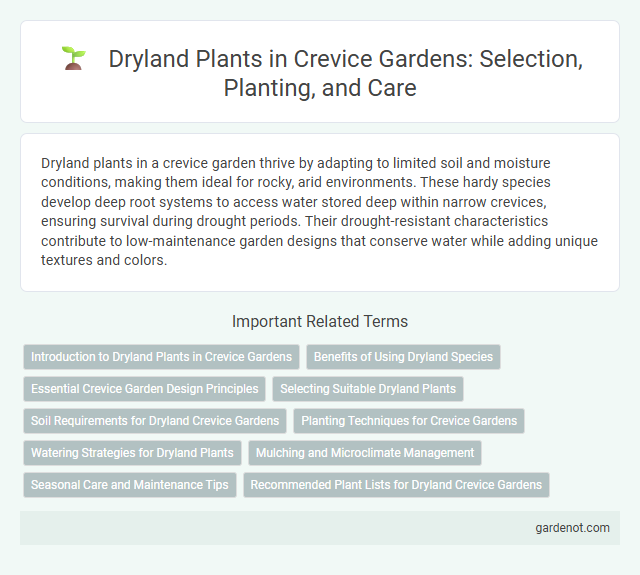Dryland plants in a crevice garden thrive by adapting to limited soil and moisture conditions, making them ideal for rocky, arid environments. These hardy species develop deep root systems to access water stored deep within narrow crevices, ensuring survival during drought periods. Their drought-resistant characteristics contribute to low-maintenance garden designs that conserve water while adding unique textures and colors.
Introduction to Dryland Plants in Crevice Gardens
Dryland plants in crevice gardens thrive by adapting to limited soil moisture and high temperature fluctuations, making them ideal for xeriscaping within narrow rock fissures. These plants, such as sedums, yuccas, and agaves, exhibit drought tolerance through deep root systems and water-storing tissues that maximize survival in arid microclimates. Crevice gardens simulate natural dryland habitats, providing optimal conditions for these specialized plants to conserve water and resist environmental stress.
Benefits of Using Dryland Species
Dryland plants in crevice gardens offer exceptional drought tolerance and require minimal irrigation, making them ideal for water-efficient landscaping. These species enhance soil stability by preventing erosion within narrow rock crevices while thriving in nutrient-poor, well-drained substrates. Incorporating dryland plants promotes biodiversity and resilience in xeriscape environments, contributing to sustainable garden ecosystems.
Essential Crevice Garden Design Principles
Dryland plants thrive in crevice gardens by utilizing narrow soil pockets that provide excellent drainage and protection from harsh weather. Essential crevice garden design principles include creating deep, narrow fissures in rock formations to mimic natural alpine habitats and ensure plant roots access moisture while avoiding waterlogging. Incorporating drought-tolerant species like sedums and saxifrages enhances sustainability, requiring minimal irrigation in arid conditions.
Selecting Suitable Dryland Plants
Selecting suitable dryland plants for a crevice garden involves choosing species adapted to low water availability and high sunlight exposure, such as sedums, sempervivums, and drought-tolerant grasses. These plants thrive in well-drained, rocky substrates, requiring minimal irrigation while providing year-round texture and color. Incorporating native dryland plants like yucca or agave enhances ecological compatibility and reduces maintenance needs.
Soil Requirements for Dryland Crevice Gardens
Dryland crevice gardens require well-draining, gritty soils with low organic matter to mimic natural rocky habitats and prevent root rot. Incorporating coarse sand, gravel, or decomposed granite improves soil aeration and moisture retention suitable for drought-tolerant plants like sedums and sempervivums. Maintaining slightly alkaline to neutral pH levels enhances nutrient availability essential for dryland plant health in crevice garden settings.
Planting Techniques for Crevice Gardens
Dryland plants thrive in crevice gardens through strategic planting techniques that mimic their natural rocky habitats. Ensuring deep and narrow soil pockets with well-draining, gritty substrates allows roots to establish firmly while minimizing moisture retention that can cause rot. Precise placement of drought-tolerant species such as Sedum, Sempervivum, and Artemisia in microclimates within the crevices optimizes sun exposure and airflow for sustained growth.
Watering Strategies for Dryland Plants
Dryland plants in crevice gardens require deep, infrequent watering to encourage robust root growth and drought resilience. Utilizing drip irrigation or soaker hoses minimizes water waste by delivering moisture directly to the root zone. Mulching around plants conserves soil moisture and maintains consistent hydration in these arid-adapted species.
Mulching and Microclimate Management
Mulching in crevice gardens with dryland plants conserves soil moisture by reducing evaporation and suppressing weed growth, optimizing water use efficiency. Carefully chosen mulch materials, such as coarse gravel or organic compost, enhance soil temperature regulation and improve microclimate conditions around plant roots. Effective microclimate management creates a stable environment, minimizing temperature fluctuations and promoting healthy growth for drought-tolerant species adapted to arid conditions.
Seasonal Care and Maintenance Tips
Dryland plants in crevice gardens require seasonal care focused on efficient water conservation and soil health. During spring, apply a slow-release fertilizer to support growth, while summer demands regular mulching to retain moisture and reduce evaporation. In fall, prune dead foliage to prevent disease and prepare plants for dormancy, ensuring minimal water access during winter months to prevent root rot.
Recommended Plant Lists for Dryland Crevice Gardens
Recommended plant lists for dryland crevice gardens include drought-tolerant species such as Sedum, Sempervivum, and Delosperma, which thrive in well-drained, rocky environments. Succulents and low-water perennials like Agave, Yucca, and Artemisia provide vibrant texture and color while conserving moisture. These plants are specifically selected for their ability to withstand arid conditions and minimal irrigation in crevice garden designs.
Dryland plant Infographic

 gardenot.com
gardenot.com